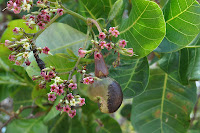By Dexter B. Dombro
 |
| One year old cashew tree. |
One of the biggest concerns for
investors in reforestation projects is the long time it takes for trees to be
ready to harvest. Ten to twenty years without cash flow is a very scary
proposition for most people. One
solution is agroforestry, with cash flow crops planted inside the tree
plantation, or to raise sheep, which can feed and fertilize around the trees. Another
option is to plant fruit trees that offer some cash flow. It is this latter option that offers some
amazing opportunities to tropical tree plantation owners. Specifically, let me talk about the
opportunities that come from the cultivation of cashew trees (Anacardium occidentale).
 |
| 3 year old cashew trees. Note the spacing. |
The cashew tree is native to the
Orinoco River basin, perfectly adapted to poor acidic soils, high rainfall
(above 2,000 mm or 79” a year), a dry season with no or little rain, and open savannah
conditions with intense sunshine when first planted. Cashew trees are now
cultivated in many equatorial regions of the world, such as India, Mozambique
and Brazil. At Amazonia Reforestation in Vichada, Colombia, they plant cashew
trees that have been grafted, using local roots, but enhanced fruit bearing
stems. The cultivation is usually done in grids of 12m by 12m or 40’ by 40’,
resulting in approximately 60 trees per hectare (25 trees per acre). The trees
naturally develop an umbrella shaped canopy that radiates some 6 meters or 20’
around from the tree trunk, hence the spacing. It allows the tree to bear a
maximum amount of fruits and therefore nuts, and makes picking of the fruits
and nuts easier.
 |
| Two year old cashew tree. |
As with any tree in poor soils,
the addition of organic material, such as cattle or chicken manure or compost
will greatly enhance fruit production. In Colombia’s plains the addition of
coffee plantation fertilizer (17-6-18-2) has been found to work
well. While the tree is not a fast growing tree, it starts producing fruit
after its third year, and by year five is considered to be producing at a commercial
rate. Commercial plantations expect to have 35 years of good productivity
before production declines, and the trees need to be replaced.
 |
| Nut and fruit form soon after flowering. |
Production will average 1 ton of
cashew nuts per hectare for 35 years. The world price for cashew nuts ranges
between $7,000 USD to $8,000 USD per metric ton FOB plantation gate. A
plantation with 100 hectares of cashew trees in marginal soils can therefore
look forward to some $750,000 USD in annual cash flow just from the nuts. But it
gets better! Each nut grows on the end of the cashew fruit. The fruits have a
gross weight that on average is 8 times greater than the nut. That means there
is 8 tons of fruit per hectare. The fruit can be processed as pulp for juices,
as dried fruit or as an extract for natural cough syrups.
 |
| Typical fruit with nut at end. |
The fruit juice has 5 times more
vitamin C per glass than does orange juice (262 mg of Vitamin C per 100
ml of juice), and the pulp has ready markets for industrial and
medicinal uses. If that isn’t of interest to you, the fruit can also be
fermented into a wine, or distilled into liquor (feni) that is popular in places like India, where demand for feni greatly exceeds available supply. There
are other uses for the tree, not the least of it being the eventual harvest and
sale of the timber once it has used up its productive life and the tree needs
to be replanted. This should give the reader an idea of just one example of the
many possible cash flow solutions that exist in tropical forestry settings. At Amazonia Reforestation and CO2 Tropical Trees this is also a socio-economic development process that offers local people opportunities.
